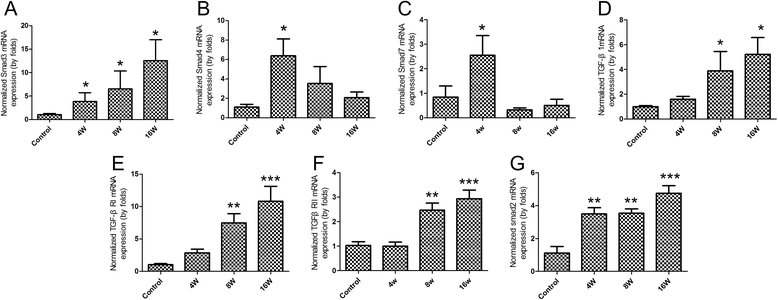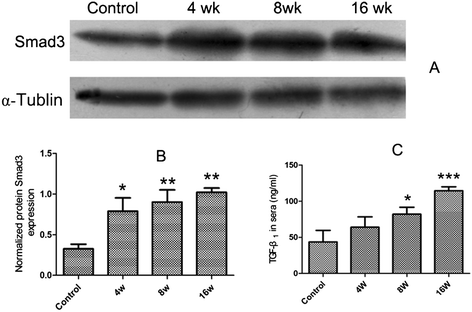The expression dynamics of transforming growth factor-β/Smad signaling in the liver fibrosis experimentally caused by Clonorchis sinensis
- PMID: 25649869
- PMCID: PMC4329204
- DOI: 10.1186/s13071-015-0675-y
The expression dynamics of transforming growth factor-β/Smad signaling in the liver fibrosis experimentally caused by Clonorchis sinensis
Abstract
Background: Liver fibrosis is a hallmark of clonorchiasis suffered by millions people in Eastern Asian countries. Recent studies showed that the activation of TGF-β/Smad signaling pathway can potently regulate the hepatic fibrogenesis including Schistosoma spp. and Echinococcus multilocularis-caused liver fibrosis. However, little is known to date about the expression of transforming growth factor-β (TGF-β) and other molecules in TGF-β/Smad signaling pathway which may play an important role in hepatic fibrosis caused by C. sinensis.
Methods: A total of 24 mice were individually infected orally with 45 metacercariae, both experimental mice and mocked-infected control mice were anesthetized at 4 week post-infection (wk p.i.), 8 wk p.i. and 16 wk p.i., respectively. For each time-point, the liver and serum from each animal were collected to analyze histological findings and various fibrotic parameters including TGF-β₁, TGF-β receptors and down-stream Smads activation, as well as fibrosis markers expression.
Results: The results showed that collagen deposition indicated by hydroxyproline content and Masson's trichrome staining was increased gradually with the development of infection. The expression of collagen type α1 (Col1a) mRNA transcripts was steadily increased during the whole infection. The mRNA levels of Smad2, Smad3 as well as the protein of Smad3 in the liver of C. sinensis-infected mice were increased after 4 wk p.i. (P < 0.05, compared with normal control) whereas the TGF-β₁, TGF-β type I receptor (TGFβRI) and TGF-β type II receptor (TGFβRII) mRNA expression in C. sinensis-infected mice were higher than those of normal control mice after 8 wk p.i. (P < 0.05). However, the gene expression of Smad4 and Smad7 were peaked at 4 wk p.i. (P < 0.05), and thereafter dropped to the basal level at 8 wk p.i., and 16 wk p.i., respectively. The concentrations of TGF-β₁ in serum in the C. sinensis-infected mice at 8 wk p.i. and 16 wk p.i (P < 0.05) were significantly higher than those in the control mice.
Conclusions: The results of the present study indicated for the first time that the activation of TGF-β/Smad signaling pathway might contribute to the synthesis of collagen type I which leads to liver fibrosis caused by C. sinensis.
Figures




Similar articles
-
MicroRNA-497 induced by Clonorchis sinensis enhances the TGF-β/Smad signaling pathway to promote hepatic fibrosis by targeting Smad7.Parasit Vectors. 2021 Sep 14;14(1):472. doi: 10.1186/s13071-021-04972-3. Parasit Vectors. 2021. PMID: 34521449 Free PMC article.
-
Characterization and identification of differentially expressed microRNAs during the process of the peribiliary fibrosis induced by Clonorchis sinensis.Infect Genet Evol. 2016 Sep;43:321-8. doi: 10.1016/j.meegid.2016.06.009. Epub 2016 Jun 4. Infect Genet Evol. 2016. PMID: 27267304
-
Exogenous bone morphogenetic protein-7 reduces hepatic fibrosis in Schistosoma japonicum-infected mice via transforming growth factor-β/Smad signaling.World J Gastroenterol. 2013 Mar 7;19(9):1405-15. doi: 10.3748/wjg.v19.i9.1405. World J Gastroenterol. 2013. PMID: 23539268 Free PMC article.
-
TGF-β/SMAD Pathway and Its Regulation in Hepatic Fibrosis.J Histochem Cytochem. 2016 Mar;64(3):157-67. doi: 10.1369/0022155415627681. Epub 2016 Jan 8. J Histochem Cytochem. 2016. PMID: 26747705 Free PMC article. Review.
-
Receptor-activated transcription factors and beyond: multiple modes of Smad2/3-dependent transmission of TGF-β signaling.J Biol Chem. 2024 May;300(5):107256. doi: 10.1016/j.jbc.2024.107256. Epub 2024 Apr 2. J Biol Chem. 2024. PMID: 38569937 Free PMC article. Review.
Cited by
-
MicroRNA-497 induced by Clonorchis sinensis enhances the TGF-β/Smad signaling pathway to promote hepatic fibrosis by targeting Smad7.Parasit Vectors. 2021 Sep 14;14(1):472. doi: 10.1186/s13071-021-04972-3. Parasit Vectors. 2021. PMID: 34521449 Free PMC article.
-
Effects of co-infection with Clonorchis sinensis on the sex hormones levels in male patients with chronic hepatitis B.J Clin Lab Anal. 2022 Sep;36(9):e24663. doi: 10.1002/jcla.24663. Epub 2022 Aug 16. J Clin Lab Anal. 2022. PMID: 36082466 Free PMC article.
-
Hepatocarcinoma-intestine-pancreas/pancreatitis-associated protein (HIP/PAP) confers protection against hepatic fibrosis through downregulation of transforming growth factor β receptor II.Lab Invest. 2020 Mar;100(3):466-482. doi: 10.1038/s41374-019-0314-x. Epub 2019 Oct 22. Lab Invest. 2020. PMID: 31641222
-
Integrative Transcriptomics and Proteomics Analyses to Reveal the Developmental Regulation of Metorchis orientalis: A Neglected Trematode With Potential Carcinogenic Implications.Front Cell Infect Microbiol. 2021 Dec 2;11:783662. doi: 10.3389/fcimb.2021.783662. eCollection 2021. Front Cell Infect Microbiol. 2021. PMID: 34926326 Free PMC article.
-
Cytokine Production in Cholangiocarcinoma Cells in Response to Clonorchis sinensis Excretory-Secretory Products and Their Putative Protein Components.Korean J Parasitol. 2019 Aug;57(4):379-387. doi: 10.3347/kjp.2019.57.4.379. Epub 2019 Aug 31. Korean J Parasitol. 2019. PMID: 31533404 Free PMC article.
References
-
- Fang YY, Chen YD, Li XM, Wu J, Zhang QM, Ruan CW. Current prevalence of Clonorchis sinensis infection in endemic areas of China. ZhongguoJi Sheng Chong Xue Yu Ji Sheng Chong Bing Za Zhi 2008, 26:99–103, 109. - PubMed
MeSH terms
Substances
LinkOut - more resources
Full Text Sources
Other Literature Sources
Medical
Miscellaneous

